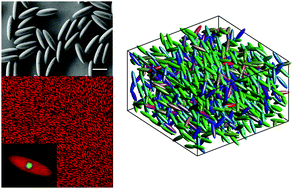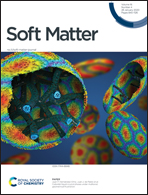Formation of nematic order in 3D systems of hard colloidal ellipsoids†
Abstract
Suspensions of hard ellipsoidal particles exhibit complex phase behavior as shown by theoretical predictions and simulations of phase diagrams. Here, we report quantitative confocal microscopy experiments of hard prolate colloidal ellipsoids with different aspect ratio a/b. We studied different volume fractions ϕ of ellipsoids in density and refractive index matched suspensions. Large 3D sample volumes were investigated and the positions as well as the orientations of all ellipsoids were extracted by image analysis routines. By evaluating the translational and orientational order in the system we determined the presence of isotropic and nematic phases. For ellipsoids with a/b = 2.0 we found that isotropic phases form at all ϕ, while ellipsoids with a/b = 7.0 formed nematic phases at high ϕ, as expected from theory and simulations. For a/b = 3.5 and a/b = 4.1, however, we observed the absence of long-range orientational order even at ϕ where nematic phases are expected. We show that local orientational order formed with the emergence of nematic precursors for a/b = 3.5 and short-ranged nematic domains for a/b = 4.1. Our results provide novel insight into the phase behavior and orientational order of ellipsoids with different aspect ratios.



 Please wait while we load your content...
Please wait while we load your content...